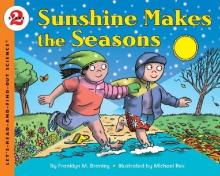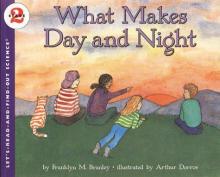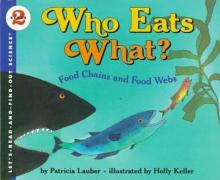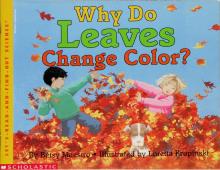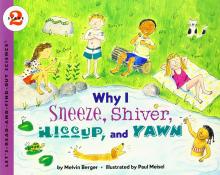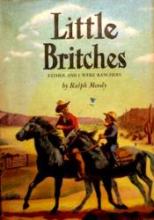No name
How do Birds Find Their Way?
A nicely illustrated and interesting look at the amazing phenomenon of bird migration, what we know about how migration works and some various theories about details that are still being studied. Includes a chart of how high various birds fly.
Sunshine Makes the Seasons
"Sunshine warms the earth. If the sun stopped shining, the earth would get colder and colder..." It is important for children to consider the importance of the sun in our lives. In Sunshine Makes the Seasons, children are introduced to the sun's role and in particular how the seasons change because of the earth's rotation around the sun and the tilt of the earth.
In a fashion similar to The Moon Seems to Change, an experiment involving an orange stuck into a pencil (again a styrofoam ball and a chopstick or pencil will work just as well) helps to illustrate the various points that are explained. First the child uses a flashlight with the "axis" of the earth pointed straight up and down to show how the seasons would always be the same in that scenario. Then we are shown that by tilting the earth, the length of each day changes throughout the year. We also see how the North and South Pole are special cases where the midwinter can have several weeks of darkness and midsummer can have continuous light. We also see that the seasons change very little at the equator and that the Northern and Southern hemispheres have opposite seasons from each other. Again, this book covers substantial information in a very simple way and will be very useful and straightforward for early science lessons.
What Makes Day and Night?
The clearly written text is combined with simple, colorful pictures to make the concepts of day and night and the rotation of the earth in relation to the sun very understandable for both young children and their parents. : ) Included is a very simple hands-on "experiment" requiring only your child and a desk lamp. Some information about the moon is also covered. Like other books in this series, this book is a great solution for satisfying some of those "why" questions that young children constantly ask.
Who Eats What? Food Chains and Food Webs
This book explores the notion of various plants and animals that are linked together based on "who eats what." Children will learn about some simple food chains such as – leaf, caterpillar, wren and hawk. They also see how one plant or animal can belong to several food chains and that members or these related food chains (food webs) have a certain amount of dependence on each other. The text goes on to explain, through an example of a problem with over-hunted otters around the turn of the century, that when part of a food chain is disturbed, the other members will also be affected. There are some mild "environmental" messages in this text which our family used as an opportunity to discuss good stewardship of what God has given us.
Why Do Leaves Change Color?
Our family has really enjoyed this book which explains why leave fall off the trees before winter, where the different colors come from, how weather affects the brilliancy of the colors and lots more. It's written in a very simple manner, so that it's quite understandable even for preschoolers or kindergarteners, and yet it contains substantial information so that even moms (like me) realize that they don't know everything : ) You'll also find labeled pictures of the leaves from different kinds of trees, a cross section of a leaf, an explanation of how trees make food, and how to make leaf rubbings and preserve leaves by ironing them between sheets of waxed paper.
Why I Sneeze, Shiver, Hiccup and Yawn
A simple book with cartoon-like illustrations that explains reflexes and the related workings of the nerovus system – focusing, of course, on those four topics mentioned in the title. The story also invites children to try out a few simple experiments to observe reflexes for themselves. A "Find Out More" section provides "Things to Think About", additional "Test Your Reflexes" ideas and "Fun Facts".
Little Britches
Little Britches
Little Britches is the first book in an eight-book series by Ralph Moody and came so highly recommended that I was concerned about being disappointed. We shouldn't have waited; it is brilliant! This book is particularly well-suited to being read aloud and will be enjoyed by every age grouping. It would be a wonderful book to have Daddy read to the family.
The titles in the series are:
- Little Britches: Father and I Were Ranchers
- Man of the Family
- The Home Ranch (overlaps in time with Man of the Family)
- Mary Emma & Company
- The Fields of Home
- Shaking the Nickel Bush
- The Dry Divide
- Horse of a Different Color
Little Britches is the first part of the story of the author's life, set in the early years of the 1900s. When he was 8 years old, his family moved from New Hampshire to Colorado in an attempt to improve his father's health. Life around the turn of the century comes alive for the reader and listeners, and the descriptions of holiday meals, special treats, school days, cattle ranching, and the weather are fascinating. The family faces many challenges that are still faced in Colorado, and the lessons they learn are applicable to all of us. Mr. Moody's father is a wise, soft-spoken, religious man who teaches his son not only what it means to be a rancher, but also what it means to be a man.
We enjoyed this book tremendously, and only partly because we can identify with the weather challenges and the fight for water rights that are a part of modern-day Colorado. We enjoyed it mostly because of the picture of a loving family, living a simple life, and working for the good of all. This story gives a more accurate picture of life on the prairies than do the Little House books, and its appeal spans a wider age range. There area few spots of cowboy-type rough language that are easily ignored if the story is read aloud. We heartily recommend Little Britches!
Frost on the Windowpane
This deceptively-simple supplement to Little House in the Big Woods packs a wallop of meaningful content into easy and fun art and writing assignments. Not only will it will help children understand the book better, but it provides full-fledged lessons in art appreciation and composition.
The bulk of this resource consists of "chapter activities" which generally include three segments:
1. "Discussion" - Simple discussion questions are intended to start conversations about the book and invite the child to compare their own life with Laura's life. Discussions such as these are excellent for reading comprehension, thinking skills, etc.
2. "Writing" - Assignments are simple and related to the story, suc as writing about a special gift you have received for Christmas. The unique thing about these assignments is that they each have a corresponding worksheet in the back of the booklet that help the child to collect his thoughts, organize ideas, and in the process learn to become a better writer.
3. "Art" - The simple art projects employ a process called "discipline based art education". Rather than simply assign a drawing based on the story, the child is presented with a famous work of art (such as Van Gogh's Bedroom by Vincent Van Gogh) which provides a good example of an artistic feature that they will use in their assignment. In the case of Van Gogh's Bedroom, the child sees how the artist made the picture three dimensional (simple instructions are included) and replicates that aspect of the painting into their own artwork (in this case a drawing of the attic). What a great way to apply art appreciation to the child's work (reminiscent of the Suzuki method in music). All of the artwork can be viewed online (websites are included) or purchased in postcard form from the publisher.
Rounding out the booklet are...
Activities before Reading, which includes projects about the four seasons and about the geography of Wisconsin
Activities after Reading, which includes instructions for making little books relating to the story, a three-dimensional diorama of a scene from the story, planning an evening "Little House Style", comparing the child's life to Laura's and some simple recipes.
I"m very pleased to recommend this very well-thought-out booklet as a worthwhile, family-friendly resource. Suitable for a wide age range, especially grades one thru five.


